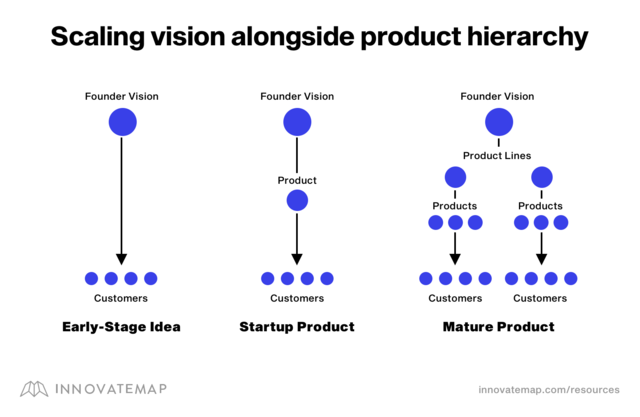
Scaling Founder Vision Alongside Product Hierarchy
Product always starts with a founder vision. This often gets lost in translation, but it’s true. This is not unique to the tech industry. In fact, this is probably the fundamental tenet of entrepreneurship. Someone who recognizes a problem or opportunity and crafts a vision for how to solve the problem.
These solutions, particularly in the tech space, often take the form of products — packaged tools or discrete solutions. And while plenty is written about how to scale a founder’s vision through the company org chart, there is less on how to scale that vision through product hierarchy.
In terms of product maturity, we typically work with three types of tech companies. The first are early-stage companies—or a person who has an idea they can barely articulate over a beer—where the vision is all that exists. The second are startups that have something in market. They’re actively trying to figure out whether they have the right solution to the problem, or whether they’ve chosen to solve the right problem to begin with. And third, we work with the fortunate tech companies that have grown to a size where they are adding multiple products either themselves or by acquisition.
In every type, the challenge lies in properly scaling or evolving the original vision through products. How do you know what products to create? What problems to solve?

Anchor your product around a central vision
This is obvious in the early stages, and honestly not that hard. It’s the driving force and the only thing you have as an early-stage startup. But as you build your first MVP, this becomes a challenge. The biggest challenge comes in the form of sifting through what customer feedback to take seriously, and what is an outlier. Rod Feuer talks about rooting his team in principles as a way to guide whether to build out features or not. Simply building everything your customers tell you is the quickest way to build a product that frustrates people. Tying high-level principles to your vision, and letting those guide your early product decisions, is critical.
But the challenges don’t end there. If your product is successful, you’ll inevitably end up adding new products either built by your team, or through acquisitions (dream big!). Aligning products to your vision can become really challenging. As you look at the graphic, more layers become introduced between the the end customer and the original vision.
Thankfully, navigating this is essentially the same as in the early stages: you ensure that all products you build also align to that central vision. On the Better Product Podcast, Amy Reitz talks about how after years, the it was the original mission of Hobson’s that helped her determine how products should be organized in their portfolio. Some products might be sunsetted, others merge. But the fundamental principles remains the same: guide all product decisions based on how well it ties to your central vision.
Make sure your messaging is written in the language of your customers
Of course, it’s not as easy as aligning everything to a vision and magically all your problems are solved. So let’s take a look at a few more practical techniques for making that a reality.
As your product grows, the way you describe it to customers can start to take a life of its own. In the beginning when the founder is selling, talking directly to prospects, they drive the messaging in real-time. They know the vision like the back of their hand, any missteps can be corrected live, and as messaging evolves, the founder has it in their head.
But as new products emerge, scaling the messaging becomes a huge problem. Sometimes the messaging becomes confusing between new products. What exactly does this new product do differently than the other? Is the market different? Other times, product leaders can become too inwardly focused. And who can blame you? If your product becomes successful, you start wanting to show it off to people. But over time your messaging can become too focused on what the product can do and shifted away from speaking to your customers’ pains. Once you introduce product lines, this grows exponentially.
No fear, the answer is simple: stop showing your product off and start asking your customers questions about their day job. How do they speak? What are their biggest challenges? These non-product questions will yield vocabulary that can influence your messaging in a big way. It doesn’t matter if you have $0 in revenue or $1,000,000,000. There’s no reason your messaging can’t be written the way your customers talk.
Align your internal team around the same message that your customers receive
This is a product article, not an organization article, but there is one important team-related consideration when it comes to scaling product vision. Again, in the early stages, this is not a big deal as the people you need to align are often sitting across the table from you. Or they’re part of the same demos or sales calls. But as product scales, so do the roles needed to support it—and that creates communication issues.
As you grow, you have to keep your team consistent from the product marketing team, to the PM and UX teams, and up to the sales and customer support teams. Cara Wagner explained on the podcast how simply introducing one new product caused a lot of customer confusion and that fixing it required diligence on making sure their product teams were completely aligned.
Once you ensure you’ve reset your messaging to be in line with your customers’ vocabulary, focus inwardly by driving consistency amongst your product teams.
Embrace change
Lastly, never get comfortable with how your vision is being scaled through product. Even if you have consistency, internal alignment, clarity with your customers, and a compelling vision binding everything together, it can change tomorrow. A new competitor, an acquisition or merge opportunity, or a market pivot can cause upheaval overnight. And that’s okay. Building a solid foundation that starts with the vision and cascades down throughout your product line will give you the right principles and rules to govern how to respond to these changes.
Scaling product never stops but the vision can remain largely unchanged. By ensuring that your product, messaging, and internal processes align to that vision, you will be able to scale your product effectively for years.



